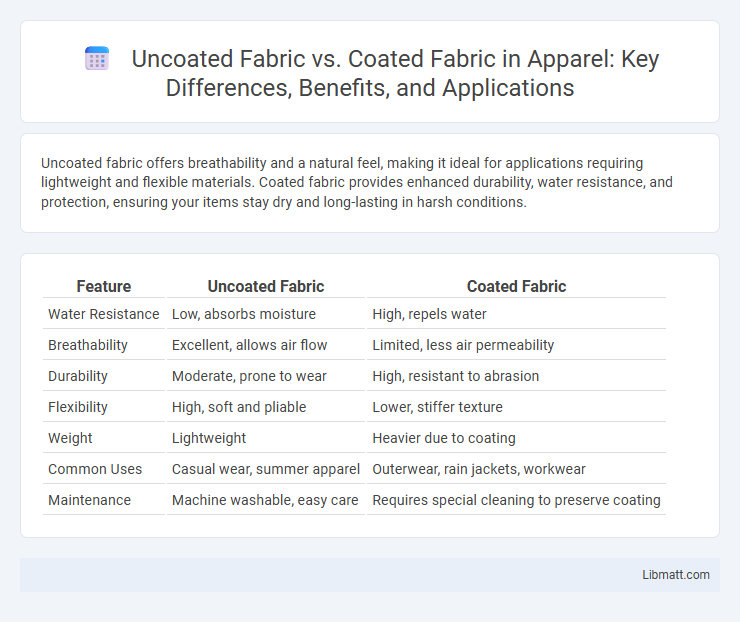Uncoated fabric offers breathability and a natural feel, making it ideal for applications requiring lightweight and flexible materials. Coated fabric provides enhanced durability, water resistance, and protection, ensuring your items stay dry and long-lasting in harsh conditions.
Table of Comparison
| Feature | Uncoated Fabric | Coated Fabric |
|---|---|---|
| Water Resistance | Low, absorbs moisture | High, repels water |
| Breathability | Excellent, allows air flow | Limited, less air permeability |
| Durability | Moderate, prone to wear | High, resistant to abrasion |
| Flexibility | High, soft and pliable | Lower, stiffer texture |
| Weight | Lightweight | Heavier due to coating |
| Common Uses | Casual wear, summer apparel | Outerwear, rain jackets, workwear |
| Maintenance | Machine washable, easy care | Requires special cleaning to preserve coating |
Introduction to Uncoated and Coated Fabrics
Uncoated fabrics are natural or synthetic textiles without any surface treatment, offering breathability and a soft texture ideal for comfort-focused applications. Coated fabrics feature a protective layer, such as polyurethane or PVC, enhancing water resistance, durability, and stain protection, making them suitable for outdoor gear and industrial uses. Understanding the core differences between uncoated and coated fabrics is essential for selecting materials based on performance needs and environmental conditions.
Definition and Characteristics of Uncoated Fabrics
Uncoated fabrics are textiles that have not been treated with any surface coating or membrane, preserving their natural breathability and softness. These fabrics are typically lightweight, flexible, and allow air and moisture to pass through, making them ideal for applications where comfort and ventilation are essential. Common examples include cotton, linen, and silk, which maintain their original texture and appearance without added surface barriers.
Definition and Characteristics of Coated Fabrics
Coated fabrics are textiles that have been bonded with a polymeric layer, such as polyurethane, PVC, or silicone, to enhance durability, water resistance, and stain repellency. These fabrics exhibit characteristics like increased abrasion resistance, improved tensile strength, and often a glossy or matte finish depending on the coating type. Their engineered surfaces make them ideal for applications in outdoor gear, upholstery, and protective clothing where enhanced performance is required.
Manufacturing Processes: Uncoated vs Coated Fabrics
Uncoated fabric is produced by weaving or knitting fibers without any surface treatment, retaining its natural texture and breathability. Coated fabric undergoes an additional manufacturing step where a polymer layer, such as PVC or polyurethane, is applied to enhance water resistance, durability, and stain protection. These coating processes include lamination, calendaring, or solvent spreading, which significantly alter the fabric's performance characteristics compared to uncoated textiles.
Key Material Differences
Uncoated fabric consists of natural or synthetic fibers left in their original state, offering breathability and flexibility, while coated fabric features a layer of polymer, such as polyurethane or PVC, applied to enhance water resistance and durability. The coating alters the fabric's texture, weight, and waterproof properties, making it less permeable but more robust against environmental factors. Uncoated fabric is typically lighter and more breathable, whereas coated fabric emphasizes protection and longevity in demanding applications.
Performance and Durability Comparison
Uncoated fabric offers breathability and flexibility but generally lacks resistance to water, stains, and abrasion compared to coated fabric. Coated fabric provides enhanced durability, improved weather resistance, and longer lifespan due to its protective layers such as PVC or polyurethane. These performance differences make coated fabrics ideal for outdoor applications, while uncoated fabrics suit indoor or light-use products.
Applications and Common Uses
Uncoated fabric is widely used in applications requiring breathability and natural texture, such as apparel, home textiles, and upholstery, where comfort and softness are priorities. Coated fabric, offering enhanced durability and water resistance, is common in outdoor gear, protective clothing, and industrial applications, providing superior protection against elements. Your choice depends on whether you prioritize breathability or weatherproof performance for your specific project.
Environmental Impact and Sustainability
Uncoated fabrics generally have a lower environmental impact due to their simpler manufacturing processes and biodegradability, often made from natural fibers like cotton, linen, or hemp. Coated fabrics, while offering durability and water resistance, typically rely on synthetic polymers such as PVC or polyurethane, which pose challenges for recycling and contribute to microplastic pollution. Sustainable alternatives in coated fabrics involve bio-based coatings or water-based treatments, aiming to reduce ecological footprints while maintaining functional benefits.
Cost Considerations
Uncoated fabric generally costs less due to its simpler manufacturing process and absence of specialized surface treatments, making it ideal for budget-conscious projects. Coated fabric involves additional layers such as PVC or polyurethane, increasing material and production expenses but offering superior durability and water resistance. Your choice between uncoated and coated fabric should balance upfront costs with the expected lifespan and functional requirements of the end use.
Choosing the Right Fabric for Your Needs
Uncoated fabric offers breathability, flexibility, and a natural texture, making it ideal for applications requiring comfort and ease of movement, such as apparel and home textiles. Coated fabric provides enhanced durability, water resistance, and stain protection, suitable for outdoor gear, upholstery, and industrial uses where performance is critical. Understanding your specific requirements for protection, feel, and function will help you choose between the breathable qualities of uncoated fabric and the protective benefits of coated fabric.
Uncoated fabric vs coated fabric Infographic

 libmatt.com
libmatt.com